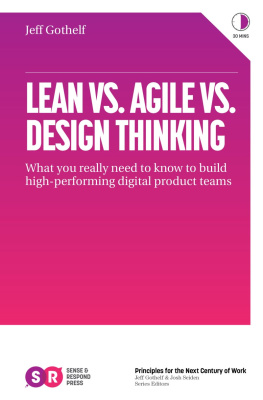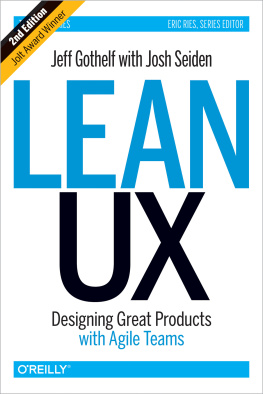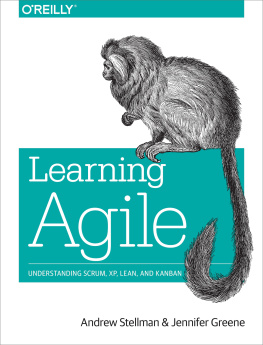Agile Experience Design
A Digital Designers Guide to Agile, Lean, and Continuous
Lindsay Ratcliffe
Marc McNeill
Agile Experience Design
A Digital Designers Guide to Agile, Lean, and Continuous
Lindsay Ratcliffe and Marc McNeill
New Riders
1249 Eighth Street
Berkeley, CA 94710
510.524.2178
510.524.2221 fax
Find us on the Web at: www.newriders.com
To report errors, please send a note to:
New Riders is an imprint of Peachpit, a division of Pearson Education.
Copyright 2012 by Lindsay Ratcliffe and Marc McNeill
Acquisitions Editor: Michael Nolan
Project Editor: Rebecca Gulick
Development Editor: Margaret S. Anderson
Copy Editor: Gretchen Dykstra
Production Coordinator: Myrna Vladic
Interior Designer and Compositor: Danielle Foster
Cover Designer: Aren Howell Straiger
Cover Production: Jaime Brenner
Proofreader: Patricia Pane
Indexer: Valerie Haynes Perry
Notice Of Rights
All rights reserved. No part of this book may be reproduced or transmitted in any form by any means, electronic, mechanical, photocopying, recording, or otherwise, without the prior written permission of the publisher. For information on getting permission for reprints and excerpts, contact .
Notice Of Liability
The information in this book is distributed on an As Is basis, without warranty. While every precaution has been taken in the preparation of the book, neither the authors nor Peachpit shall have any liability to any person or entity with respect to any loss or damage caused or alleged to be caused directly or indirectly by the instructions contained in this book or by the computer software and hardware products described in it.
Trademarks
Many of the designations used by manufacturers and sellers to distinguish their products are claimed as trademarks. Where those designations appear in this book, and Peachpit was aware of a trademark claim, the designations appear as requested by the owner of the trademark. All other product names and services identified throughout this book are used in editorial fashion only and for the benefit of such companies with no intention of infringement of the trademark. No such use, or the use of any trade name, is intended to convey endorsement or other affiliation with this book.
ISBN-13: 978-0-321-80481-5
ISBN-10: 0-321-80481-3
9 8 7 6 5 4 3 2 1
Printed and bound in the United States of America
Acknowledgements
We are extremely grateful to everyone who has contributed to this book. In particular, we would like to thank the people who have created and contributed original content in the form of both words and pictures. We are also grateful to everyone who has kindly given us permission to include their thoughts, work, products, or mug shots in this book, and also to those who have given us feedback throughout the process. A big thanks to the team at Peachpit who have supported us throughout this intense process and helped make this book what it is!
Lindsay would like to give special thanks to my hubby, Guy Ratcliffe, without whom nothing would be possible. Your love, support, and constant encouragement have made my dreams come true. To my little man who melts my heart even on stressy days. To my Dad, who kept the faith and always believed in me. The thought of your smile still warms my heart, and Ill miss you always. To my Mum whose strength, perseverance, and determination continue to inspire me. To my brother whose unfaltering pursuit of the good life leaves me in awe. To Marc McNeill, thanks for your inexhaustible energy and passion about all things XD. Thanks for sharing this journeywe make a great team! To Hubertus B and StakenKidney, you are my mentors and muses eternal. To the PufaSistas, the other half of BitchnCharmer, I am eternally grateful for what was, what is, and what always will be. To Andrew, Sarah & Shane, you were there, where it all began, and continue to influence and inspire me. To Claire and my other Witches of EastTwick(enham), you are all amazing and your support and friendship are invaluable. A big shout out to all my good friends and colleagues at ThoughtWorks who have inspired my fresh perspective on design, customer experience, and technology, and supported both of us through this process.
Marc gives a big thank you to Graham Donaghue for giving me the nudge to write this book and to Luke Barrett for his inspiration and support. Thanks to all the ThoughtWorkers, both past and present, who have patiently listened to me rant about the real customer whilst Ive waved my hands in front of the whiteboard. Theyve taken me on a journey of agile discovery, from thinking a class was something I went to school in, to having a humble appreciation for the noble art of software delivery. Of this merry bunch, thanks in particular to Alex McNeill, Dan North, Luca Grulla, JM Domaingue, Prashant Gandhi, Jeff Patton, and my fellow experience designers Eewei Chen, Darius Kumar, and Diana Adorno. Thanks to my co-author Lindsay, who agreed to come on this journey and took it to the next level. And finally thanks to my wife, Lindsey, for the patience and understanding shes given me as Ive written.
Foreword
As it enters its second decade, the agile movement must continue to innovate and adapt to remain relevant. This book by Lindsay Ratcliffe and Marc McNeill continues a string of agile innovations and adaptations. It brings design back into the software delivery equation. But, but, agilists might say, we always do design. But Ratcliffe and McNeill are not talking about module design or database design; theyre talking about product design, graphic design, experience design, and more. This level of design is one of those things that is hard to define, but Ill know it when I see it. As the authors say, great design marries a desirable product with an engaging experience, a combination found in Apples iPhone and iPad, for example.
IN A WORLD ENRICHED BY ABUNDANCE BUT DISRUPTED BY THE AUTOMATION AND OUTSOURCING OF WHITE-COLLAR WORK, EVERYONE, REGARDLESS OF PROFESSION, MUST CULTIVATE AN ARTISTIC SENSIBILITY... TODAY WE MUST ALL BE DESIGNERS.
Daniel Pink, A Whole New Mind
The early agile movement was a reaction to the problems of waterfall development: splintering of roles, piles of documentation, and little collaboration. The remedies to the problems of waterfall included working in short iterations, reducing the proliferation of roles, slashing documentation, and fostering intense collaboration. But, as it turns out, specialisation wasnt the primary problemcollaboration was. As the agile movement has matured, weve added back specialists as weve learned to integrate them into agile teams. Thats not to say that having a more general set of skills isnt very valuable, but in our complex world there is still a need for expertise in certain areas.
Another trend over the last decade has been to show how, in a variety of ways, the statement agile wont work for or with xyz is false. Issues with large projects, distributed teams, database-centric products, legacy systems integration, non-greenfield development, specific technologies, and practices like user-interface and experience design have all been addressed by innovative agilists.
Agile Experience Design: A Digital Designers Guide to Agile, Lean, and Continuous continues these trends by showing how experience design can be integrated into agile products and how designers can be integrated into agile teams. The book delves into the many facets of design and how they can be incorporated to create an engaging experience for customers, and brings the critical issues of design to designers and non-designers alike.










